This is the
first Newsletter for 2007 so it gives me the opportunity to
express my sincere thanks to the Committee and all the Helpers
for the fantastic support and commitment that I received
throughout 2006.
Last year, the
weather was not very kind to us for the earlier Air Shows but
improved vastly, allowing Eastern Region to enjoy a very
successful year. Our Christmas Lunch was again a very enjoyable
occasion. Alan and his staff at The Squadron looked after us
very well indeed: Many thanks to Alan and his crew!
We were all
delighted to have Alex Henshaw and Norman Lyons as our guests.
The success and future of The Spitfire Society was toasted with
a glass of Bollinger, many thanks again to Alex. As if that
were not enough, Alex also presented us with a superb Gerald
Coulson framed print. We hope that it will be our Raffle Prize
at the “Flying Legends” Air Show at Duxford next July.
Last November
had its sad side as well, firstly, when we heard that Harry
Griffiths, the Executive Chairman of The Spitfire Society had
passed away. We were later to learn that our former and very
enthusiastic Chairman, Philip Insley had died. A tribute to
Philip appears later in this Newsletter.
The loss of
Harry Griffiths will affect The Spitfire Society in its
entirety. It is now up to the larger Regions, and we are one,
to offer all the support that they can. Eastern Region will
certainly co-operate in every possible way.
After many
years of dedicated service on our Committee our Webmaster, John
Fitzgerald, has found it necessary to resign due to an increased
work-load and family commitment. I would like to thank John
very much and wish him good health and prosperity. We are
though very pleased to welcome two young people to our
Committee: Gerard Crutchley who is to become our new Webmaster,
and Robert Schofield who will assist with Events. We are also
pleased to report that former Committee Member Paul Plummer has
rejoined us and will particularly look after the interests of
Members in Norfolk and Suffolk. Welcome Paul!
There remains
now for me to hope that you will all enjoy excellent health and
very best wishes for 2007.
David Williams
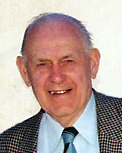

--------------------------------------------
In Memoriam
Harry Griffiths
On the 28th of
November 2006 the Chairman of the Spitfire Society, Mr. Harry
Griffiths died.
Harry was a
popular Chairman whose commonsense 'hands on' approach to the
job endeared him to all who came into contact with him. If you
had a problem he would help find a solution and would far rather
get involved in things personally than delegate, this despite
the inevitable march of advancing years. Indeed, few people
would be likely to have suspected that Harry was in his
nineties, as everything about him suggested a man very much
younger.
Leading the
Spitfire Society into the Twenty first century, Harry occupied a
unique position in the story of the world's most famous combat
aircraft since he was the last surviving member of the original
design team working under R.J. Mitchell. Those were exciting
times for a young Harry Griffiths and he would, typically, get
involved himself at the cutting edge whenever possible, a good
example of this being the laboratory testing of the first
pressurised Spitfire cockpit in which Harry was the Guinea pig.
Harry was working at the forefront of Spitfire development
throughout the aircraft's history, and post war was involved
with Supermarine's jet aircraft programmes, finally leaving the
company in 1960. Along with a lifelong interest and expertise in
the field of metallurgy, Harry also developed a great love for
etymology and, the study of the English Language, his knowledge
of which was legendary. Harry was a Chairman who very much
understood the importance of the Regions to the Spitfire Society
and with his passing we lose not just a fine leader but a good
friend. The Eastern Region Membership and Committee extend our
sympathy to Harry's family for their sad loss.
Philip E Insley
We regret to announce that former Eastern Region
Chairman Philip Insley died in Norwich after a battle with
cancer on the 27th of November 2006.
The following paragraphs were written by Philip
for Regional Newsletter No. 9 August 1993 to introduce himself
to Eastern Region Members.
Philip Insley was born in Birmingham at Castle
Bromwich in 1944 and both his parents worked at Castle Bromwich
Aeroplane Factory before and during the War, his Mother in the
Drawing Office, his Father as Assistant Manager at the Flight
Shed to which, as a young child, Philip was frequently taken.
His interest in Spitfires and Castle Bromwich was furthered in
later years by contacts with his Father’s former colleagues and
by the collection of a large number of photographs and records
from Castle Bromwich.
An Architect by profession Philip was a
Conservation and Design Officer, holding positions in
Canterbury, Coventry and Shrewsbury before arriving at Norwich
City Hall in 1990, where he dealt with the conservation of
historic buildings in the City. He retired in June 2005 at the
age of 61.
Philip joined The Spitfire Society as a Life
Member in 1984 and was co-opted onto the Eastern Region
Committee as Norfolk Representative in Summer 1992. After the
death of our first Chairman Pat Butler in May 1993, Philip was
elected Regional Chairman in 1994. He was an excellent Chairman
and will perhaps be best remembered by the work he did with
Committee Member Ron Gould and the Arnold Scheme Stearman
Association to set up an annual “Members’ Day” which was held at
the Shuttleworth Collection in those days and enjoyed by Members
from virtually every part of our Society.
His death is a great loss to the Spitfire
Society.

--------------------------------------------
Jan Linzel
Part II
If you have not read Part I, you can find it
here:

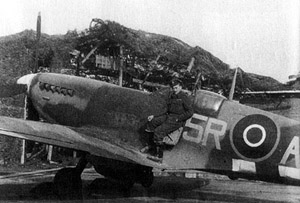
In the winter
1940/1941 the KLM had a course in Amsterdam for Navigator 2nd
class, which I followed and did my examination in March 1941.
Then all courses were forbidden by the Germans.
In July 1941
I went with four fellows to Brussels. In the night we crossed
the border, we almost ran into a German patrol. From Brussels we
went into occupied France through zones interdite, to the
demarcation line which we crossed in the night. We were arrested
by the Vichy police but got away with the help of a policeman
who was very anti-German. Finally we made it to Soler, west of
Perpignan near the Spanish border. We landed in a Dutch camp
which was very bad and some blokes were already more than a year
there. The ones who tried to get through to Spain were all
caught and put in Mitander concentration camp. The distances
were too big and the Seguridad Spanish Gestapo was
everywhere, thick as flies.
I saw no
point in staying there and decided to return to Holland. One of
the others went with me but their colleague stayed because the
Gestapo was very much looking for them. The trouble was, we had
no contacts and in the railway station of Lons de Saunier
we were arrested. Luckily the police were completely in the
underground movement and they put us in an hotel and arranged a
crossing over the demarcation line. With about two dozen French
people, some women, we walked at night about twenty miles in the
rain and pitch black night. Crossed three rivers. We had to
undress, put our things in to the rain coat and waded up to our
chests through the cold current. We managed to cross the
French/Belgium and the Belgium/Dutch border without trouble and
I arrived home again. Lost quite a few pounds though. Over this
journey I could write a book. I was in the underground movement
again and we also started an underground paper. As we did this
with only five people and took every possible precaution, it was
never discovered by the Gestapo till the end of the war. In the
winter 1941/1942, which was very severe and there was not much to
eat and very little fire for a stove, I followed a forbidden
course for Navigator 1st class. I did not finish the course
because I left the country in April 1942 again. The Gestapo were
looking for me and I had to disappear. The underground had a
good route to Switzerland. I took three Jews with me and with
false papers we managed Switzerland in two days. Over this
journey I could write many pages.
At the Swiss
border we were caught by the Swiss and put in prison in
Pottenbruy. The Swiss were friendly. There was a whole crowd of
people in the prison, mostly French and a few Dutch Jews, nice
blokes. After two days we went to a prison in Bern and after
that six weeks in a prison near Lake Mort. Then I was six weeks
in a hotel near Geneva and then put into a labour camp. We were
there with about 120 Dutch men and had to drain a marsh. As the
Dutch authorities wanted to do everything legally it was
difficult to get further. From August 1942 I worked in the Dutch
consulate in Zurich, where I made a lot of friends and had a lot
of fun. I even went skiing. I gave up with the legal way, which
never would work!
Beginning
January 1943 with another Dutchman I crossed the border at
Geneva and walked 50 km during the night to Auncey, where we had
an address. From here we went after a few days to Prepping. Here
we had an address and a Basque farmer took us first by train and
then seven hours walking in the Pyrenees. In the middle of the
night we arrived at a small farm. There were already 18
Frenchmen and we joined them with two more Dutch men. All the
time people were on guard in case of German patrols. Next night
they took us across the Pyrenees.
We split up
in three separate groups and walked all night. During the day we
slept in the undergrowth. The next night we were walking across the
terrain by compass. The road was dangerous as there were
patrols of the Spanish police. That night I had trouble with my
left leg and I was holding up the group. I managed to convince
the others, after a lot of protests, that it was better for me
to walk along the road instead of holding up the group and, by
five o'clock in the morning I arrived in the little town of Banjolas. I was pooped. In the square was a large hotel "Hotel
Mundial" and I went in. A sleepy old porter wrote my name in the
register and the number of my false passport. He took me by lift
several floors higher and I got a very luxurious room where I
took a bath and went to bed. The next day I awoke about eleven
o'clock and wondered where I was for a moment then, with a
shock, I remembered and dressed quickly, rushed downstairs and
there were two Spanish ladies in black dresses sitting near a
charcoal fire. They laughed when they saw me and with a bit of
French made clear that not everything was "Kosher" with me. They
took me to the dining room, where a big meal was served for me.
That was terrific, for I had not eaten for days.
I had to go
to Barcelona. I had to go by the 4 o'clock train from Gerona and
by bus. I was not allowed to pay the hotel. They gave me the
exact fare for the train and I had only to say "Express
Barcelona" at the ticket office. They didn't expect any control
by Seguridad. Everyone getting on the bus had his or her papers
checked. The owner of the hotel gave me a ticket for the bus and
when I entered the police looked the other way. In the train to
Barcelona there was control and I was arrested. They put me in
Barcelona prison. About this prison I can write pages. I was
bought free by the Vice Consul, who was a Spaniard and only
spoke Spanish and French. He paid 200 pesetas and a big box of
cigars. He seemed to know the Seguridad people well.
By night
train I went to Madrid and arrived at around noon at the
Embassy. Handed over 144 micro photos which I had taken as
courier from Switzerland. I got something to eat and a railway
ticket to Cadiz, where I arrived the next day, to take a Spanish
boat to South America, which went via Curacao where I intended
to leave the ship. The police chief, who told me he would die
for Hitler and Spain found something wrong with my papers and I
was not allowed on the ship which left without me. The police
chief told me that I was not allowed to stay in Cadiz and also
that I was not allowed to leave Cadiz. Typical Spanish. I
thought to hell with it, and took the night train to Madrid. I
was arrested on the train and landed in the dungeons of the
Seguridad. That was underneath a beautiful palace they occupied
at the "Puerto del Sol" Not nice and full of bugs. The Embassy
discovered I was there and they got me out of it and I was put
in a hotel. A lot of things happened in Madrid, but that is a
story in itself. Finally on the 27th May I left for Lisbon and
further on 6th June with the first night flight of the K.L.M. to
Bristol. About a week before, the Germans had shot down an
aircraft (with among others Lesley Howard)
We had
breakfast in Bristol airport and then were taken to London under
guard. When I saw the balloons over London I was awfully
pleased: I had reached my goal, England!
After a week
at "Patriotic School" I was handed over to the Dutch. Over this
episode I also can write half a book, but finally I joined
"Allied L Squadron" in a big flat building Abbey Lodge, Park
Road, Regents Park. I had to learn English and I was kitted out
here. On the sixth of September I was posted to R.A.F. Cranwell. Two
days later I was sent to Caistor Airfield (South of Grimsby).
Here I had a refresher course on Miles Master 11s and after four
weeks sent back to Cranwell College. They told me I had to
do a course in an AFU and as all courses were full I could go on
indefinite leave. I said that I did not want to go on indefinite
leave as that was not what I had come over for. So I stayed at
the college. It was nice. I had a nice room a batman and
followed all kind of lectures. But I wanted to fly. I talked to
the Flying Wing Adjutant F.Lt. Bowen who was also billeted in
the college. He said he would show me to the Wing Co. Next
morning the Wing Co said "You cannot fly here" I said "Why not?
You have so many aircraft here." Bowen said, "Old Weddup in
maintenance is always looking for a pilot to test aircraft,
it's just the job for him" Wing Co said "O.K. go to Weddup and
test bloody aircraft, and buzz off." I was flying a lot,
followed lectures and did a lot of hours in the Link trainer. I
was great friends with Bowen and often played squash with him.
But I was only a Sergeant pilot, I said to Bowen "I want a
Commission" He said "You'll have to see the Wing Co, he has the
forms in the drawer of his desk" Next morning I was shown in,
"What does he want now?" I said "I want a commission." "We
cannot give you a commission - we hardly know you! " "Well you've
got the forms in your drawer, why cannot I try?" He threw the
forms on the desk and said, "0.K. here are the forms and buzz
off" Three weeks later I was Pilot Officer.
They had
Spitfires there as well. They were training a crowd of Turks. I
told Bowen that it was about time I started flying on Spits.
Next morning he showed me in at the Wing Co's again. "Oh hell,
there he is again, what does he want this time?" "He wants to
fly Spits" said Bowen, "he cannot fly Spits here!" said Wing Co,
I said "Why not? There are plenty of Spitfires here and the
bloody Turks are flying them" The Wing Co said "O.K. go and fly
the bloody Spits, now clear off and I don't want to see you
again, ever."
That
afternoon I was solo on Spit. Mark1; you had to pump up the
undercarriage. So when I was not flying for Old Weddup I was
flying Spits. Then the Spitfire Course went to Dumfries for
gunnery. I went with them of course. I could do so as I was
still on indefinite leave. I did air to air and air to ground
and in the middles of the course there came a telegram, that I
had to return to Cranwell immediately. It turned out I was
posted to AFU in Turnhill. When they saw my log book they said
"What the hell are you doing here?"
I was 14 days
at Turnhill and then went to the satellite station Condover.
After finishing the course I was posted to Eshott,
Northumberland between Alnwick and Morpeth. O.T.U. Then to
satellite Boulmer for gunnery and from there to T.U.U. at
Tealing 6 miles north of Dundee. Here we were on Spit 5Bs and
also were air defence, which was of course a dead loss those
days in Scotland. Three scrambles. I volunteered for rocket
course in Kinnell. On 25th July I was posted to G.S.U. in
Thruxton and on 3rd August to No.33 Squadron at Selsey Bill.
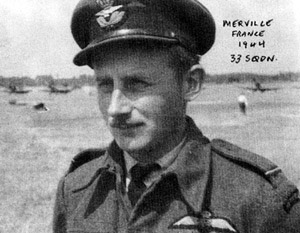


--------------------------------------------
My National Service in The Royal Air Force
by George Morgan
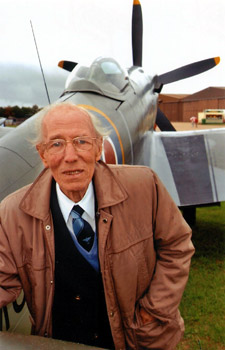
It was in
December 1943 that I volunteered for Air Crew in the RAF. I
passed my medical examination and was told I'd be called up in
Feb. '44. I was posted to Padgate in Cheshire. I was there about
six weeks, and during that time I did a lot of Square Bashing,
learning how to use a rifle, a Sten gun and side arms. From
there I was posted to an American air base at Melton Mowbray in
Leicestershire, where I was put on Aircraft Inspection and
taught what to look for when a 'plane was being serviced. I was
there about six months.
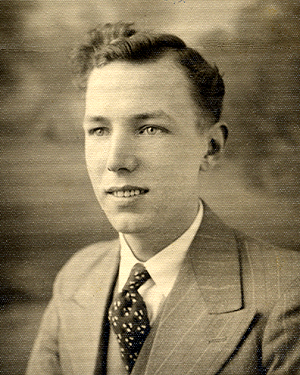
I was then
posted to Nottingham to a much smaller air base where I was to
report for Flying Instruction. My first encounter with a plane
was the Tiger Moth . After a few instructions and a short flight
we were put into the cockpit of a Spitfire to familiarise
cockpit layout, learning all the controls. Then came taxiing and
after that solo flight, but before this I found that something
was going wrong with my eyes. They would mist up. I'd give them
a slight rub and my eyesight was back to normal. Come the day of my
solo flight, I taxied out to the runway and took off. No sooner
had I got in the air when I turned round and came back. My
instructor asked me what was wrong and I told him. I was sent
for an eye examination and ended up having to wear glasses.
My short flying days were over.
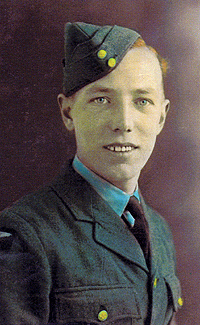
I was then posted
to Staffordshire to an A.I.D. base, 'Aircraft Inspection Dept'.
This was like a supermarket for aircraft parts. Orders would
come in from all over the place and our job was to inspect these
parts before they were sent out. I was finally released from the
RAF in 1947. I am now a member of The Spitfire Society and have
been for nearly twenty years, and enjoy every minute of it.
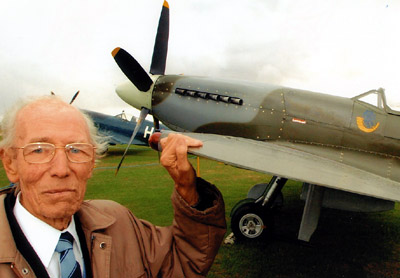

--------------------------------------------
Lancaster Navigator,
W/0. John Lee
Part I
Interviewed by Peter Wesson
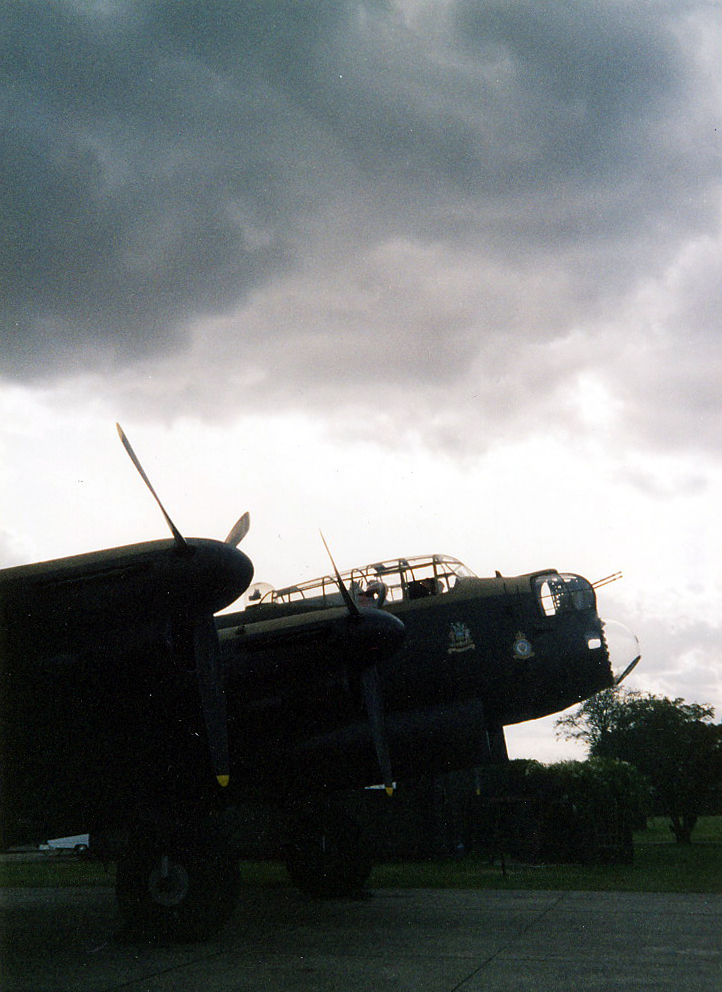
John Lee's aviation career began with basic
training on Tiger Moths. He recalls:
"We did twelve hours pilot training then, you
see, when you joined up it wasn't for anything specific, it was
called a PNB scheme: Pilot, Navigator, Bomb‑aimer, and it was
up to them what they needed, you know, if they were short of
pilots they'd have pilots, or if they wanted navigators -
anyway, that's how it worked. 'The first place I went to after
joining up was St. Johns Wood, right opposite London Zoo; luxury
flats they were, beautiful you know, all glass and mirrors and
polished floors, I thought "this is the life!" Anyway, we
weren't there long, we did a bit of Square‑bashing, and we used
to go into the zoo ‑ although of course they'd evacuated the
animals - for our inoculations.
After that there was a bit of a log‑jam, so we
were posted to Ludlow. We got off at the station, we had all our
flying kit and everything, and we marched for about three miles
and we got to a field and looked out ‑ and this was in November
- Bell Tents! "Surely not," I said, "not the RAF, Bell Tents?"
It was! We were building the camp, digging ditches. Hell of a
shock that was, after the luxury flats! Anyway, we were there
for quite a while before we were posted to Aberystwyth, that's
where we did the initial training. We used to go into the
University, along the Prom, for lessons and that type of thing.
The next place I went to was Desford,for pilot training on
Tiger Moths‑ that was great fun. And then from there we went to
Heaton Park in Manchester, where we all assembled and they
started calling out names for Pilots, Navigators, Bomb‑aimers.
Of course we all wanted to be Pilots because they were the
Rock‑stars of 1940 you know. But no, I didn't make the Pilots,
I'd done quite well at Navigation, and so I was a Navigator.
Then we went up to Scotland and caught the 'Aquitania'
and went across to New York, and from there to Moncton, New
Brunswick, which was a holding unit."
Following a three‑day
train journey across the magnificent Canadian countryside John
arrived at Brandon, Winnipeg, and was from there bussed to No.1
Central Navigation School at Rivers.
"That's where the real navigation training
started." He continues, "We were
flying Ansons. It was winter when we arrived there, very cold,
snow everywhere. But it was quite hilarious, we had horses on
the station and we used to go riding - mind you, I never liked
horses, never trusted them, only horses under a bonnet, you
know. Anyway, we used to go skiing behind the horses but they
were half‑wild, I think they were Indian ponies or something.
They didn't like me, they always used to throw me off, anyway."
What were John's memories of the Avro Anson?
"Well, very
good for what they were, you know, they were good old
work-horses and reliable. But very cold; there was a pipe came
out near the navigation table and that was supposed to be warm
air. But it was cold air and all it did was blow your papers up
and down, so we used to plug it off. But they were very good.
We used to get time off, odd weekends in
Winnipeg‑ that was a nice little place, and did quite a bit of
skating on the river, that was fantastic. After we finished the
course we were given a fortnight's leave, so my pals' and I went
down to Toronto and then on to New York. I don't know if you've
ever heard of the Stage‑Door Canteen during the war? It was a
place in New York where the stars from Hollywood used to come
and entertain the boys, it was quite good, that. And then a
family with the Red Cross took the two of us in and we stayed
with this family for two or three days, just outside New York.
It was lovely. He'd been over to England in the First World War,
had us up half the night singing First World War songs!
Anyway, we reported back eventually. We went
back to Moncton, New Brunswick, and we came back on the 'Ille de
France', nothing like the boat we went out in, it was a bit of
an old tramp‑steamer I think. And of course this time there were
U‑Boats about and we weren't escorted at all. 'It was alright
going out with the Aquitania', because that was faster than the
U‑Boats, but this thing coming back wasn't. I don't think we
would have gone faster than a rowing boat! Anyway, we finished
up in Scotland, and then came down to Harrogate, another Holding
Unit. From there we went to Northern Ireland and once more we
were doing Navigational Training with Ansons. We used to fly
down this way (near Llandovery) a lot, down to Tregaron and used
to do practice bombing in the Carmarthen Bay, that was our place
for dropping bombs - well, they were dummy bombs of course! And
sometimes up to Scotland, the islands round there. We still
didn't have a crew at this time, it was all different pilots and
what have you."
John was based at
Bishops Court Airfield in Northern Ireland for about five weeks,
during which time he recalls that it rained every day and they
were constantly "Up to our eyes in mud!"
OPERATIONAL TRAINING
The next part of John's odyssey took him to 28
OTU at RAF Wymeswold in Leicestershire:
"When we got there they put us all in this big
hanger: there were pilots, navigators and bomb‑aimers, gunners
and engineers, and the C.0. came along and said "Right, find
yourselves a crew." Anyway, we're looking round and this chap
comes up to me, he wasn't very tall, he was a Scotsman, and he
says "Have you got a crew?" and I said "No, still looking," he
said "Well, how do you feel about coming with Me then?" so I
said "Fine, but be prepared for me to lose you a few times won't
you?" and he replied "Yes, well you be prepared for a few bumpy
landings too!" I'll never forget that."
The pilot's name was 'Sandy' Taylor, from
Inverarie. Wireless Operator Bob Knight was also from Scotland,
and went on to become a close friend of John's. Aged nineteen,
Mid‑upper Gunner Roy Gilson coincidentally came from John's
hometown of Castleford in Yorkshire. The Flight Engineer and the
Bomb‑aimer came from Glasgow and Canada respectively, and the
Rear Gunner ,a big, stocky man of around forty called 'Nobby'
was from Sheffield.
"He proved to be the best signing we ever made, because he was
like a father, you know. He'd make sure that we all got up in
time to go on parade, because I was never very good at getting
up in the morning ‑ I still aren't ‑ that sort of thing. He was
with us all the time. And so we were crewed‑up then, that's when
we started working together.
At Wymeswold, in Wellingtons. They were a
beautiful plane to fly, the pilot loved them. When we came in to
land after a trip I could still keep writing on my log, no
bother. It was a bit different later on, but we used to get on
well with the Wellingtons. I remember one trip I did, I was
walking along somewhere near the runway there when an officer
came up and said "What are you doing?", I said "Nothing, I've
got nothing on today," he said "There's a crew just going off on
a trip, go with them."
Not best pleased about the idea, John
nonetheless did as he was told, and the bomber was soon crossing
the west coast, heading out to sea .It soon became clear that
the Navigator was in trouble, as John asked:
“Where's your
turning point then?" The Navigator replied "I don't know,
there's some land over there," 'I said "Yes, that's Ireland,
don't go there, give him (the Pilot) a reciprocal course," so we
gave him a reciprocal course to turn around and come back. And
in the meantime, as we were coming back, the pilot had trouble
with one of the engines, and he said "The engine's overheating,"
or something, I thought "Oh, great, I'm a spare Bod here as
well," there was a bit of superstition there, we didn't like
flying with another crew. Anyway, he said "I'm going to have to
feather this engine," and asked where was the nearest place to
get down. 'Well we were over Wales by this time and I've got my
ears and eyes open and I'm watching the map with the Navigator,
and we worked out a course to a 'drome. When we got there we
called up, but we couldn't get permission to land, there was
no‑one there.' By now the Wellington was losing altitude, and
they decided to make their way to an American airbase just a
little further on. 'So we called up, and they said "OK, come on
in Buddy." But we couldn't get the wheels down then because the
engine that he'd feathered was the generator that operated the
hydraulics on the wheels. So he said "Right, crash positions,
I'm going to have to make a belly landing." 'So everybody
got down behind the bulkheads, and we came in and he said
"Right, I'm landing now‑ brace yourselves," and next thing there
was a big bump, dust and muck flying about all over the place,
and eventually it stopped. We used to do 'Abandon Aircraft'
drill, getting out of a bent (you know, a damaged plane); I bet
we got out of that plane far quicker than we ever did in
practice! "
With no injuries apart from a cut
finger to the Rear‑Gunner, this was an adventure that John could
have done without, and he vowed never to fly with another crew
again if he could help it, though this was not to be the last
landing incident.
Next stop was a Conversion Unit near Doncaster,
where the crew finally got to grips with the mighty Avro
Lancaster. John recalls it being rather daunting to move onto
these huge aircraft from the smaller and much lower Wellingtons,
and that the Lanc's were not the best examples, being rather
worn‑out. As part of the conversion onto the Avro bomber, part
of the routine was to carry out 'Circuits and Landings, which
led to the following incident:
"Next day we were on Circuits
and Landings again but what they were doing, they'd decided to
dig a trench down the side of the runway; they were going to fit
pipes for a new thing that was coming out for fog dispersal.
They used to light it up, warm air would then lift the fog so
you could land in foggy weather, which was great because this
station at Doncaster was also an emergency station - you know,
you could be diverted there. In fact, we were diverted
there one night, but that was later on. 'Anyway, we'd done a few
landings and Sandy comes in again to land and he caught a
cross‑wind and drifted a bit and he dropped one wheel in this
trench. When he came to the end of the ditch, that smashed the
wheel, the plane spun round - oh, the propellers were all broken
and stuff flying everywhere!"
John
laughs as he recalls the incident and of the pilot's
apprehension at having to explain the accident to the C.O.
From here it was onto Op's; 5th February 1945,
Waltham nr. Grimsby with 100 Squadron .
Part II can be found here:


--------------------------------------------
Remembrance Sunday 2006
Once again the Annual Remembrance Day Service at
the North Weald Airfield Memorial was blessed with bright
sunshine and blue skies as a large congregation gathered to pay
their respects. Many wreathes were laid including that of The
Spitfire Society, which was laid by former Eastern Region
Chairman and 241 Sqn. Pilot Dennis Nichols. The Minister for the
Act of Remembrance was the Reverend H.R.M. Harries MBE, former
Assistant Chaplain‑in‑Chief of the Royal Air Force.
The 2006 Service, hosted by North Weald Parish
Council, marked the 90th anniversary of this historic airfield
and the sacrifices made by those who served there. Prior to the
service a special salute was made by a P51 Mustang which roared
up from the airfield, wheeling and soaring in the sunlight in
tribute to The Fallen. Thank you to The Royal British Legion and
to Eric Horwood for assistance with the Spitfire Society wreath.
Prior to Remembrance Sunday, on Friday the 10th
November, Regional Member Squadron Leader lan Blair DFM appeared
on television on the Paul O'Grady Show talking about the
significance of Remembrance Day and why it is so important that
we wear our poppy with pride.
lan spoke about being a young man of just twenty
when he first fired his guns in anger, of the friends and
colleagues that he lost, and said that the youngsters of today
should remember that “Freedom is hard won". It was a heartfelt
and emotive interview, which will have touched the hearts and
thoughts of millions of viewers across the nation.
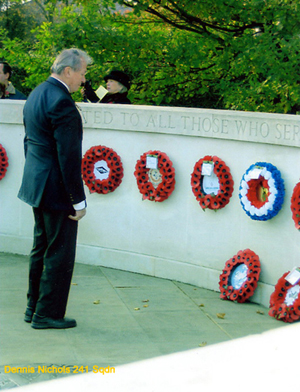

--------------------------------------------
Junior Members'
Science Museum Visit 2006
October 2006 saw the Spitfire
Society's Junior Membership gathered to view the special
exhibition dedicated to the Spitfire and it's Chief Designer
R.J.Mitchell at the Science Museum in London. The day began with
a talk from our Chairman Mr. Harry Griffiths who for nine years
worked alongside R.J.Mitchell as part of the team responsible
for the design of the Spitfire. Harry began by outlining the
early life of Mr. Mitchell and his astonishing rise to the
position of Chief Designer at Supermarine aged just twenty‑five,
and how R.J. honed his skill for creating sleek, fast aircraft
with successes in the world‑famous Schneider Trophy air‑races of
the 20s and 30's (of which Harry himself remembers watching the
1929 race from a barge in the middle of the course!).
Moving on to talk about the
development requirements of the new fighter, such as finding
accommodation for the wheels, guns and ammunition within the
thin elliptical wing with it's special multi‑layered box‑section
main spar, Harry recalled the quote that "The only straight line
on a Spitfire is the aerial‑mast," which he says may not be
quite accurate, but is not far off it and is what helps make the
aeroplane look so special.
Harry then went on to talk
about the progression of the aeroplane through it's many
different marks and the various ways in which the speed was
gradually increased, including, at Harry's suggestion, the
addition and removal of split‑peas to simulated dome headed
rivets to a test aircraft in order to ascertain any difference
in speed to an aircraft built with flush‑headed rivets, which
turned out to be an astonishing twenty‑two mph.
Following Harry's superb talk
the party made it's way to the second floor where, alongside an
impressive slate sculpture of R.J.Mitchell, Spitfire Mk.22 PK664
is displayed in it's component parts of wings, fuselage,
empennage, engine, nose, and guns, giving the viewer a unique
insight into the composition and construction of the aeroplane.
Nearby, display cases house a variety of wonderful items
relating to the Spitfire including personal items once owned by
R.J.Mitchell, the tunic worn by Flt. Sgt. George 'Grumpy' Unwin
DFM, the flying log‑book of Gp. Cpt. Hugh 'Cocky' Dundas DSO DFC,
a special section on Mitchell's successor, the brilliant Joseph
Smith, and a host of other treasures all supplemented by video
shows.
After lunch we were treated to
a guided tour by museum staff‑member Rob Skitmore of the main
Aircraft Hall, home to many wonders including Alcock and Brown's
Vickers Vimy, Amy Johnson's DH Moth, Hurricane L 1592,
Spitfire la. P9444, Supermarine S6.B, and the Schneider
Air‑races Trophy. At all times Harry Griffiths was on‑hand to
talk about the exhibits and answer questions. The day was
attended by a goodly proportion of our Junior Members who
enjoyed a splendid visit and will in years to come be able to
tell their own children that they spent a day in the company of
one of the design team of the worlds most famous fighter
aeroplane. The Juniors were each presented with a special
'Goodie‑bag', and given the opportunity to enter a competition
for a signed book. Also in attendance was former Coastal
Command Pilot Sqn. Ldr. Len Dixon. Len has flown a wide variety
of aircraft, and I took the opportunity to ask him what his
favourite types were, to which he replied that the Lockheed
Neptune was his preferred multi‑engined machine, for twins the
Mosquito, and for a single motor the Spitfire, of which he flew
the Mk.XVI.
As well as our Chairman, from
HQ came Alyson Long, who organised the visit, photographer Mike
Bayliss, and our new Hon. Treasurer Richard Brown with his wife
and grandson. Eastern Region Committee was represented by David
Williams, Peter Wesson, and Regional Photographer Eric Horwood.
Well done to Alyson Long for organising a superb visit for our
Junior Members which I am sure they will long remember.
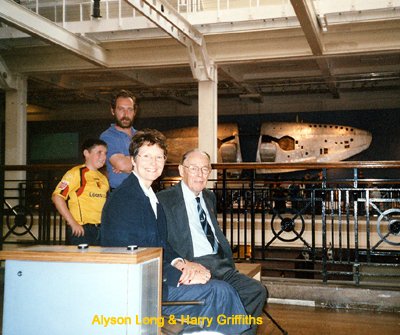
This review of the visit to the Science Museum
was written before our Chairman Mr. Harry
Griffiths
passed away. Few of us on the visit were aware of how unwell
Harry was, as he went through the day with energy and
enthusiasm, illustrating so well Harry's selflessness, stoicism
and determination.

--------------------------------------------
Christmas Lunch 2006
The Eastern region Helpers' Christmas Lunch at
North Weald's 'The Squadron' was once again a great success,
with nearly forty people in attendance. We were delighted to
have with us a fine contingent of former wartime pilots
including lan Blair, Peter Cunningham, Ron Gould, Bert Harman,
Norman Lyons, Dennis Nichols, Len Stillwell, David Williams, and
our Special Guest, Spitfire Society Vice-chairman Mr. Alex
Henshaw MBE who very kindly and generously donated a beautiful
signed and framed limited edition print of a Spitfire to us.
Inevitably there was a note of
solemnity in the air, as the event took place just days after
the sad loss of not one but two highly esteemed figures from the
Spitfire Society, our Chairman Harry Griffiths, and former
Eastern Region Chairman Philip Insley. I am sure that the
thoughts of all of those present were often with the relatives
and loved ones of Harry and Philip. However, the show must go
on, and everyone enjoyed what was a most convivial occasion. As
with previous years, the table looked delightfully festive and
the food and service were faultless, due to the hard work of the
ladies at The Squadron, to whom we offer our thanks. Thanks also
to Alan Crouchman, and especially to David Williams who once
again organised the day for us.

--------------------------------------------
Aircraft Safari U.S.A.
by Jason Amiss

On my recent holiday to Arizona in the USA, I was
fortunate enough to be able to visit two very interesting
aircraft museums, these being the Commemorative Air Force Museum
at Falcon Field, Phoenix, and the Pima Air and Space Museum in
Tuscon; incorporated in with this museum is the chance to visit
the Davis Monthan Air force Base, famously known for it's desert
bone yard, but more of that later...
The Commemorative Air Force museum was formed in
1957 by a group of Texas aviators who were dismayed to see so
many WW11 combat 'planes gradually being destroyed, so they
obtained a few aircraft and began to put on small shows and
displays for the public. By 1963 they made the decision to
collect every type of American WWII combat aeroplane including
heavy/medium bombers as well as Navy dive/torpedo bombers. By
1972 this task was completed and the collection currently
consists of over 145 aircraft, of which over one‑hundred are
flyable at any given time. On the day of my visit I was very
fortunate to be at the museum when the CAF's B.17 'Sentimental
Journey' returned from being away on a two‑month tour of the
U.S. air show circuit' and seeing it arrive in the bright blue
desert sky was an incredible sight, one which 1 will long
remember. After the B.17 had taxied in, it was opened up to the
public and I had a great time clambering through the fully
restored interior of the aircraft. The museum itself is very
small, but has a lovely collection of static exhibits such as
the T.6, C.45, F.4 Phantom, B.25 Mitchell, AFS2 Guardian, Mig
15, Mig 21, A.26 Invader, SE5.a, a Schweizer glider and, in
flying condition, the B.17 and Mitsubishi Zero.
The PIMA Air and Space Museum in Tuscon exhibits
over 275 aircraft, and is apparently the largest museum
collection of aircraft in the world (obviously I cannot list all
the 'planes in this article, but I do have the official list
which I would gladly copy and pass on to anyone who is
interested). On the morning of my visit I was fortunate enough
to be able to tour the restoration facilities, as I had
previously corresponded by E‑mail with the Restoration Manager
who kindly invited me before I arrived on the day. Their main
projects at present are the full restoration of an A.20 Havoc,
Alpha jet, B.26 Marauder, B.36j Convair Peacemaker, Blenheim
Mk.IV, Curtis Owl, P.51 Mustang, Martin Mariner, Seasprite, and
of some interest to our members a Hawker Hurricane, which has
just been completed in the markings of 257 Sqn. It has no serial
number as it is composed of several different airframes, the
majority coming from an aircraft built at Fort William, Canada,
in 1942 which crashed into a lake in St. Johns, Quebec.
Incorporated within this museum is the 390th
Bombardment Museum.
This
separate hanger was built completely by volunteers and
ex‑members of 390, and contains a fully restored B.17 and
hundreds of artifacts relating to the group. The museum is
staffed by members of the group, and I was extremely privileged
to spend half an hour chatting with them over a cup of coffee.
The 390th operated from Framlingham in Suffolk, and their combat
records in brief are; 300 Op's, 19,000 tons of bombs dropped,
179 aircraft lost, 378 EA destroyed, 78 probable, two Unit
Citations, and six Battle Streamers.
After lunch, I took the guided coach tour over to
the Davis Monthan Airforce base which includes the famous
'Desert Boneyard'. The base is an A10/OA10 Warthog Training
Facility, and as you spend time here you become quite used to
seeing the rather unusual sight of pairs of A1Os chasing each
other across the desert sky almost continuously all day. As you
pull into the base itself, you are greeted by the incredible
sight of row upon row of aircraft as far as the eye can see. The
collection consists of over 5,000 aircraft of all varieties,
including helicopters. Our tour guide informed us that they have
the fourth largest air force in the world at this site alone,
with a value of nearly sixty‑billion dollars-worth of aircraft.
The facility consists of three main sections; 1) Aircraft which
will be returned to service, 2) Aircraft to be used for parts,
and, 3) Aircraft to be sold for scrap metal. The main reason for
the location of the site is the low rainfall and humidity in the
desert and the hard ground which negates the need for tarmac or
concrete stands. The aircraft are inspected and cleaned, covered
with paper, and sprayed with 'Spraylat' to reflect sunlight and
protect sensitive instruments, and provided they are inspected
regularly they can stay out there indefinitely.
Unfortunately, as you may have noticed, I had no
sighting of a Spitfire on my visits; I am informed that
static/museum‑worthy examples are hard to come by in the USA, so
at least we can say that's something we do better than our
friends across the pond.
I hope that my experiences have been of some
interest and if anyone would like more information on the places
visited, please contact me at:
jasonamiss@spitfiresociety.org.uk


--------------------------------------------
Committee News
Regional Webmaster John Fitzgerald has for the
last few years done an excellent job of running the Eastern
Region Website. Refreshed at regular intervals with new and
interesting material, the Website has been a constant delight to
anyone with an interest in aviation, and the Spitfire in
particular. That John should have been able to maintain such a
professional looking site whilst suffering a serious long-term
illness is tribute to his dedication. The good news is that
John's health problems are in remission and that he is now able
to once again devote himself to fulltime work and his family.
Unfortunately this does not allow time for running the Website,
and so John has now left the Eastern Region Committee and closed
the Website. John has been a highly valued member of our
Committee who will be greatly missed. We would like to thank him
for his input over the years and for his fine work running our
Website. Best wishes for the future, John, and if you are able
to make it to the Sales Stand at air shows or any of our other
get-togethers we will always be very pleased to see you.
As one door
closes two others open and we are delighted to announce that
Regional Members Gerard Crutchley and Robert Schofield have
joined the Committee. Both Bob and Gerard have become familiar
faces on air show days assisting on the Sales Stand, and did
sterling service at the last Duxford Spitfire Day helping to
look after the static aircraft exhibits. Gerard has offered to
take up the reins of organising a new Regional Website,
and Bob will be looking at organising events and visits, two
very worthwhile jobs indeed. We thank both gentlemen for
volunteering their time and bid them a hearty welcome on board.

----------
Form 700
is produced by Peter Wesson and Dennis Nichols. Photographs by
Peter Wesson, Eric Horwood & Jason Amiss.

